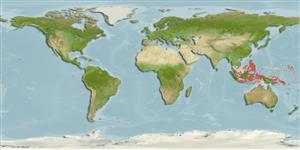>
Eupercaria/misc (Various families in series Eupercaria) >
Labridae (Wrasses) > Cheilininae
Etymology: Pteragogus: Greek, pteron = wing, fin + Greek, ago = to drive (Ref. 45335).
More on authors: Fowler & Bean.
Environment: milieu / climate zone / depth range / distribution range
Ökologie
seewasser riff-verbunden; tiefenbereich 2 - 12 m (Ref. 90102). Tropical; 19°N - 12°S
Western Central Pacific: Indonesia, Philippines, Solomon Islands, New Guinea and Palau.
Size / Gewicht / Alter
Maturity: Lm ? range ? - ? cm
Max length : 9.0 cm TL Männchen/unbestimmt; (Ref. 48636)
Rückenflossenstacheln (insgesamt) : 9; Rückenflossenweichstrahlen (insgesamt) : 9 - 10. This species differs from P. cryptus by having a concave rather than straight dorsal head profile, a higher modal gill raker count, and a series of five well-defined dark brown spots on the mid lateral line (these spots may be present on some P. cryptus, but are never well-defined). Best identified by the thin white barring on dorsal fin and upper sides (Ref. 48636). SL to 57 mm.
Found in sheltered inner reefs amongst broken coral and rubble. Usually seen in less than 10 m depth, staying well hidden in reefs, but sometimes swimming amongst the long-spined Diadema urchins or in thick algae coverage (Ref. 48636).
Life cycle and mating behavior
Maturities | Fortpflanzung | Spawnings | Egg(s) | Fecundities | Larven
Oviparous, distinct pairing during breeding (Ref. 205).
Myers, R.F., 1991. Micronesian reef fishes. Second Ed. Coral Graphics, Barrigada, Guam. 298 p. (Ref. 1602)
IUCN Rote Liste Status (Ref. 130435)
Bedrohung für Menschen
Harmless
Nutzung durch Menschen
Tools
Zusatzinformationen
Download XML
Internet Quellen
Estimates based on models
Preferred temperature (Ref.
123201): 28.2 - 29.3, mean 28.9 °C (based on 1017 cells).
Phylogenetic diversity index (Ref.
82804): PD
50 = 0.5010 [Uniqueness, from 0.5 = low to 2.0 = high].
Bayesian length-weight: a=0.01585 (0.00707 - 0.03555), b=2.95 (2.76 - 3.14), in cm total length, based on LWR estimates for this (Sub)family-body shape (Ref.
93245).
Trophic level (Ref.
69278): 3.4 ±0.4 se; based on size and trophs of closest relatives
Widerstandsfähigkeit (Ref.
120179): hoch, Verdopplung der Population dauert weniger als 15 Monate. (Preliminary K or Fecundity.).
Fishing Vulnerability (Ref.
59153): Low vulnerability (10 of 100).
Nutrients (Ref.
124155): Calcium = 133 [77, 249] mg/100g; Iron = 0.882 [0.490, 1.699] mg/100g; Protein = 18.5 [15.6, 20.7] %; Omega3 = 0.158 [0.093, 0.265] g/100g; Selenium = 18.9 [10.1, 36.7] μg/100g; VitaminA = 167 [49, 652] μg/100g; Zinc = 2.1 [1.4, 3.3] mg/100g (wet weight);
